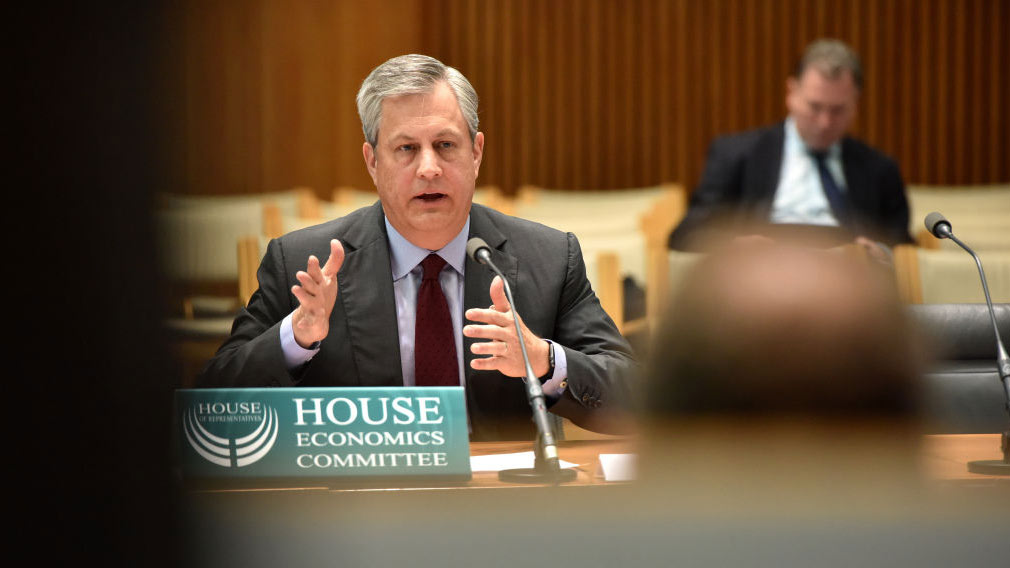Hartzer says home loan switch is on

Westpac Group CEO Brian Hartzer at the House of Representatives Standing Committee on Economics hearing in Canberra. (Getty Images)
Westpac chief executive officer Brian Hartzer says more borrowers are switching to paying down principal on their home loans from interest only mortgages.
Appearing before the House of Representatives Standing Committee on Economics, Mr Hartzer said this was a desired outcome at this point in the property and economic cycle when interest rates were around 50-year lows. He added the Reserve Bank of Australia was not concerned about the banking industry’s loan quality, but rather the impact on the broader economy if consumers reduced spending amid rising interest rates.
In June, Westpac lowered variable owner occupier principal and interest rates by 8 basis points, and increased variable interest only rates by 34 basis points after the Australian Prudential Regulation Authority in March installed a 30 per cent cap on the flow of new interest only home loans. Westpac made the changes to meet the cap and also readjust the shape of Westpac’s overall home loan book towards borrowers paying both principal and interest.
In response to questions, Mr Hartzer told MPs that in Westpac’s view responding to the APRA requirement by simply stopping lending was not the best option for customer choice.
“In a bank we always have to balance regulatory requirements, our funding structures and what's right for customers and what's right for the bank. In this case, our view and our experience was that a response of increasing the interest rate on interest only lending, reducing the interest on principal and interest lending, and communicating with customers and encouraging them to switch for free was the best way to achieve the outcome of the regulator and do the right thing for the customers.”
Chief financial officer Peter King explained that the rates for existing customers were adjusted alongside new customers to assist the desired shift in the bank’s mortgage book towards principal and interest loans and away from interest only, which make up around 50 per cent of exposures.
Mr Hartzer said while the bank always assessed potential commercial implications of decisions, it was too early to know the impact on profits because of customers switching to principal and interest only loans.
"Pricing is a judgement,” Mr Hartzer said. "In this case we found and continue to find it very hard to know what the net effect is going to be because we don't know what the switching is going to be."
Mr Hartzer said customers chose interest only loans for tax and cash flow reasons, and often had cash balances in linked offset accounts that provided a greater equity cushion. Interest only loans also typically amortised about the same as when borrowers paid principal and interest, he said.
He rejected an allegation that the bank was using APRA’s 30 per cent cap – which Mr Hartzer reiterated the bank would meet – as a “profit centre”.
He also said that shareholders had worn the cost of the government’s new bank levy announced in the May Budget, not customers or employees. But he stood by his comments that there was no “magic pudding” and the cost of the tax would be borne by stakeholders over time.
At the parliamentary hearing – the third since last year – MPs also questioned Mr Hartzer and Mr King about the banks’ recent axing of ATM fees for non-customers and “tap and go” card payments.
Mr Hartzer said banks didn’t make large profits on “interchange fees” from merchants when customers use cards, saying Australia had some of the lowest interchange fees in the world and they were essentially a “cost recovery” mechanism. While interchange fees were higher on Visa and Mastercard networks for contactless payments than the new eftpos functionality, he said customers benefited from the global credit card providers’ innovation, and scale, plus other rewards associated with credit cards.
Mr Hartzer said customers voted with their feet and used branches and ATMs less. But he said Westpac invested more than $100m combined in these networks last year given their ongoing importance to many customers, including in regional areas where services could also be accessed at some Australia Post stories and via video conferencing at traditional branches.
"We're very conscious of the concerns in regional Australia around branches,” he said.
Given the high costs of operating banks, including branches and ATMs, Mr Hartzer said Westpac was open to discussing with the industry the option of forming a utility that operated a shared ATM network in the future.
As all industries grapple with rapidly changing technology, Mr Hartzer said while jobs being replaced was a "real issue" for the economy, technological advances were also freeing up workers’ time for higher value activities. He said Westpac was investing heavily to ensure people can adapt as jobs evolve, citing its focus on this as part of its workforce revolution.
"We recognise it is a real issue for the company and we've been spending a lot more money investing in our people's skills and in the ability to create work that's more flexible and help people move around and try different things. And I think that’s the best investment we and other businesses can make is giving our people more skills so they can adapt as jobs evolve,” he said.
Additional reporting by Emma Foster.



